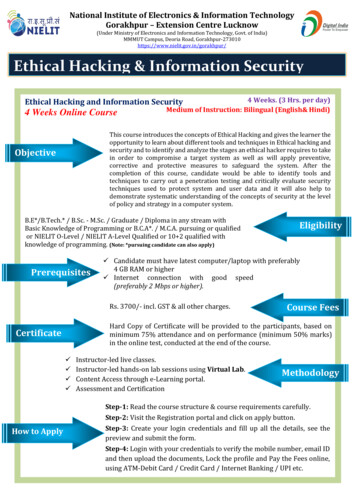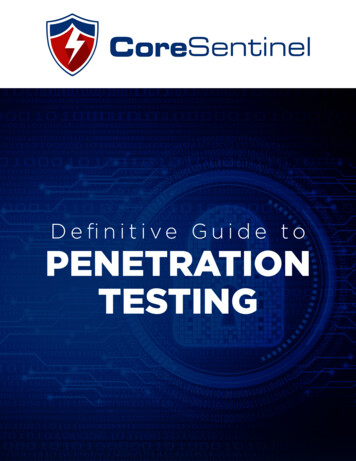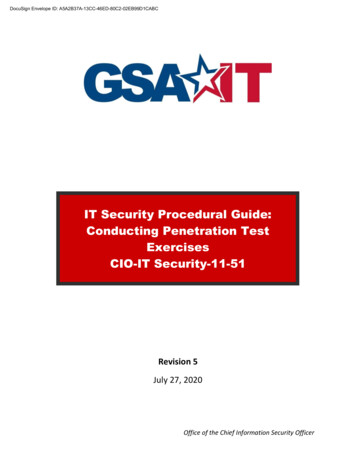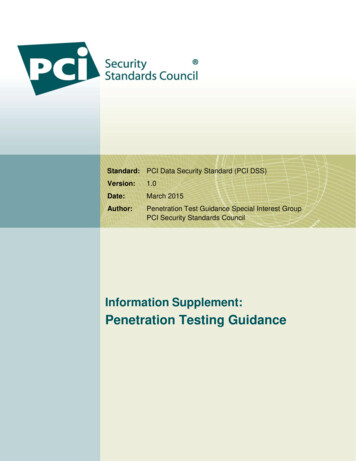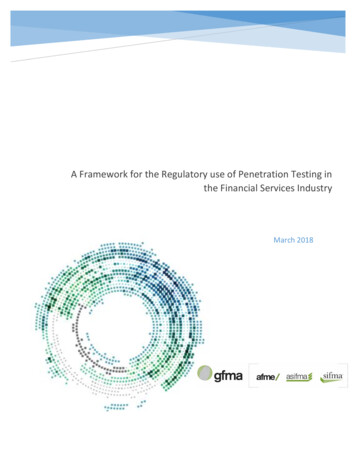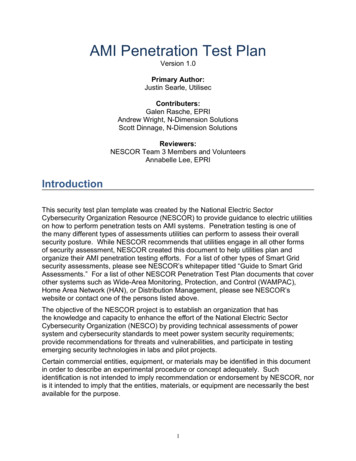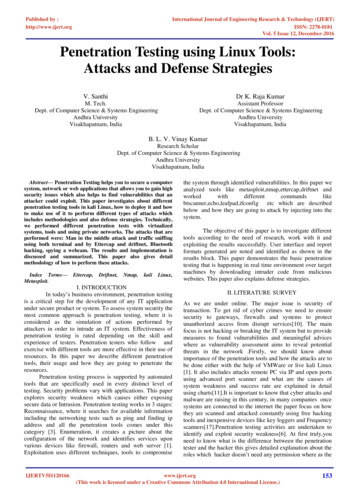![Penetration Testing Report For [CLIENT] - UnderDefense](/img/36/anonymised-infrastructure-penetration-testing-report.jpg)
Transcription
Penetration Testing Reportfor[CLIENT]
Executive summaryThis report presents the results of the “Grey Box” penetration testing for [CLIENT]Infrastructure. The recommendations provided in this report structured to facilitate remediationof the identified security risks. This document serves as a formal letter of attestation for therecent [CLIENT] Infrastructure Penetration Testing.Evaluation ratings compare information gathered during the course of the engagement to “bestin class” criteria for security standards. We believe that the statements made in this documentprovide an accurate assessment of [CLIENT] Infrastructure.We highly recommend to review section of Summary of business risks and High-LevelRecommendations for better understanding of risks and discovered security issues.ScopeSecuritylevelGradeInfrastructure perimeterCFairUnderDefense Grading Criteria:GradeSecurityCriteria DescriptionAExcellentThe security exceeds “Industry Best Practice” standards. The overallposture was found to be excellent with only a few low-risk findingsidentified.BGoodThe security meets with accepted standards for “Industry BestPractice.” The overall posture was found to be strong with only ahandful of medium- and low- risk shortcomings identified.CFairCurrent solutions protect some areas of the enterprise from securityissues. Moderate changes are required to elevate the discussed areasto “Industry Best Practice” standardsDPoorSignificant security deficiencies exist. Immediate attention should begiven to the discussed issues to address exposures identified. Majorchanges are required to elevate to “Industry Best Practice” standards.ConfidentialGrey-box Infrastructure Penetration Testing Report for [CLIENT]1Revised 31.10.2018
FInadequateSerious security deficiencies exist. Shortcomings were identifiedthroughout most or even all of the security controls examined.Improving security will require a major allocation of resources.Assumptions & ConstraintsAs the environment changes, and new vulnerabilities and risks are discovered and madepublic, an organization’s overall security posture will change. Such changes may affect thevalidity of this letter. Therefore, the conclusion reached from our analysis only represents a“snapshot” in time.Objectives & ScopeOrganization[CLIENT]Audit typeGrey-Box Manual and Automated Infrastructure PenetrationTestingAsset URLAPPENDIX A - ScopeAudit periodOct. 10 - Oct. 31Consultants performed discovery process to gather information about the target and searchedfor information disclosure vulnerabilities. With this data in hand, we conducted the bulk of thetesting manually, which consisted of input validation tests, impersonation (authentication andauthorization) tests, and session state management tests. The purpose of this penetrationtesting is to illuminate security risks by leveraging weaknesses within the environment that leadto the obtainment of unauthorized access and/or the retrieval of sensitive information. Theshortcomings identified during the assessment were used to formulate recommendations andmitigation strategies for improving the overall security posture.Results OverviewThe test uncovered a few vulnerabilities that may cause users session hijacking, sensitive dataleakage, broken confidentiality and integrity and availability of the resource. Security testingactivities showed that there are a lot of components with known vulnerabilities.Identified vulnerabilities are not directly exploitable but the risk posed by these vulnerabilitiescan cause significant damage to the company.ConfidentialGrey-box Infrastructure Penetration Testing Report for [CLIENT]2Revised 31.10.2018
Security experts performed manual security testing, which demonstrate the following results.Severity# of issuesCriticalHighMediumLowInformationa l015161Severity scoring: Critical - Immediate threat to key business processes.High – Direct threat to key business processes.Medium – Indirect threat to key business processes or partial threat to businessprocesses.Low – No direct threat exists. Vulnerability may be exploited using other vulnerabilities.Informational – This finding does not indicate vulnerability, but states a comment thatnotifies about design flaws and improper implementation that might cause a problem inthe long run.ConfidentialGrey-box Infrastructure Penetration Testing Report for [CLIENT]3Revised 31.10.2018
Summary of business risksHigh severity issues make direct threat to the business as they can be used to: Using XSS attack it is possible to steal user session and get full access to user’s account.It will lead to client data leakage as this vulnerability is present on application whis isused by company clients. Successful exploitation of this vulnerability will create bigreputational and financial damage for company.Medium and low severity issues can lead to: Attacks on communication channels and as a result on sensitive data leakage andpossible modification, in other words it affects integrity and confidentiality of datatransferred.Information leakage about system components which may be used by attackers forfurther malicious actions.Attacks on old and not patched system components with bunch of publicly knownvulnerabilities.Enumerating existing users emails/usernames and brute forcing their passwords. Easyaccess to their session after exploitation of high level risks, as session token is the samefor each login.Social engineering, intimidation or blackmail is possible via sending emails from openSMTP server, which can interrupt working process, cause credentials stealing or can beused with combination with other attacks.Combination of few issues can be used for successful realisation of attacks.Informational severity issues do not carry direct threat but they can be used to gather usefulinformation for an attacker.High-Level RecommendationsTaking into consideration all issues that have been discovered, we highly recommend to: Conduct current vs. future IT/Security program review;Establish Secure SDLC best practices, assign Security Engineer to a project to monthlyreview code, conduct SAST & DAST security testing;Review Architecture of application;Deploy Web Application Firewall solution to detect any malicious manipulations;Continuously monitor logs for anomalies to detect abnormal behaviour and fraudtransactions. Dedicate security operations engineer to this task;Implement Patch Management procedures for whole IT infrastructure and endpoints ofemployees and developers;Continuously Patch production and development environments and systems on regularbases with latest releases and security updates;Conduct annual Penetration test and quarterly Vulnerability Scanning against internaland external environment;Conduct security coding training for Developers;Develop and Conduct Security Awareness training for employees and developers;ConfidentialGrey-box Infrastructure Penetration Testing Report for [CLIENT]4Revised 31.10.2018
Develop Incident Response Plan in case of Data breach or securityincidents;Analyse risks for key assets and resources;Update codebase to conduct verification and sanitization of user input on both, clientand server side;Use only encrypted channels for communications;Improve server and application configuration to meet security best practises;Also we recommend to conduct remediation testing of both infrastructure and webapplications.Performed tests All set of applicable OWASP Top 10 Security ThreatsAll set of applicable SANS 25 Security ThreatsCriteria LabelA1:2017-InjectionStatusMeets criteriaA2:2017-Broken AuthenticationFails criteriaA3:2017-Sensitive Data ExposureFails criteriaA4:2017-XML External Entities (XXE)Meets criteriaA5:2017-Broken Access ControlMeets criteriaA6:2017-Security MisconfigurationFails criteriaA7:2017-Cross-Site Scripting (XSS)Fails criteriaA8:2017-Insecure DeserializationA9:2017-Using Components with Known VulnerabilitiesA10:2017-Insufficient Logging&MonitoringConfidentialGrey-box Infrastructure Penetration Testing Report for [CLIENT]Meets criteriaFails criteriaN/A5Revised 31.10.2018
Performed TestsStatusHost and service enumerationFails criteriaWeak passwords attack and brute-forceFails criteriaIdentification of misconfigurationsFails criteriaVulnerability identification and system exploitationFails criteriaSearch Engine Discovery and Reconnaissance for InformationFails criteriaLeakageWeak Authorization Mechanisms testingMeets criteriaDatabase compromising, sensitive information stealingMeets criteriaOutdated servicesS3 bucket enumerationFails criteriaMeets criteriaSecurity tools used Burp Suite Pro [Commercial ssusHydraHarvesterSublisterConfidentialGrey-box Infrastructure Penetration Testing Report for [CLIENT]6Revised 31.10.2018
MethodologyOur Penetration Testing Methodology grounded on following guides and standards: Penetration Testing Execution StandardOWASP Top 10 Application Security Risks - 2017OWASP Testing GuideSANS: Conducting a Penetration Test on an OrganizationThe Open Source Security Testing MethodologyOpen Web Application Security Project (OWASP) is an industry initiative for web applicationsecurity. OWASP has identified the 10 most common attacks that succeed against webapplications. These comprise the OWASP Top 10.Application penetration test includes all the items in the OWASP Top 10 and more. Thepenetration tester remotely tries to compromise the OWASP Top 10 flaws. The flaws listed byOWASP in its most recent Top 10 and the status of the application against those are depicted inthe table below.ConfidentialGrey-box Infrastructure Penetration Testing Report for [CLIENT]7Revised 31.10.2018
Findings DetailsReflected Cross Site Scripting in multiple pagesSEVERITY: HighLOCATION: https://client.com/explore/categories/dir" img src a onerror alert(1) https:// client.com/ explore/categories/dir'-alert(1)-'https:// client.com/ member/login/r/dir" script alert(1) /script https:// client.com/ page/dir?" script alert(1) /script https:// client.com " script alert(1) /script https:// client.com " script alert(1) /script https:// client.com " script alert(1) /script https:// client.com 9" script alert(1) /script https:// client.com /something1/something1/something1?" script alert(1) /script ISSUE DESCRIPTION:Cross-Site Scripting (XSS) attacks are a type of injection, in which malicious scripts are injectedinto otherwise benign and trusted websites. XSS attacks occur when an attacker uses a webapplication to send malicious code, generally in the form of a browser side script, to a differentend user. Flaws that allow these attacks to succeed are quite widespread and occur anywherea web application uses input from a user within the output it generates without validating orencoding it.An attacker can use XSS to send a malicious script to an unsuspecting user. The end user’sbrowser has no way to know that the script should not be trusted, and will execute the script.Because it thinks the script came from a trusted source, the malicious script can access anycookies, session tokens, or other sensitive information retained by the browser and used withthat site. These scripts can even rewrite the content of the HTML page.ConfidentialGrey-box Infrastructure Penetration Testing Report for [CLIENT]8Revised 31.10.2018
PROOF OF VULNERABILITY:The attacker can inject javascript code sent in URL directly to html code which will ir%22%3E%3Cimg%20src a%20onerror tialGrey-box Infrastructure Penetration Testing Report for [CLIENT]9Revised 31.10.2018
https://www.client.com/something/dir?" script alert(document.cookie) /script RECOMMENDATIONS :Preventing XSS requires separation of untrusted data from active browser content. This can beachieved by: Using frameworks that automatically escape XSS by design, such as the latest Ruby onRails, React JS. Learn the limitations of each framework's XSS protection andappropriately handle the use cases which are not covered.Escaping untrusted HTTP request data based on the context in the HTML output (body,attribute, JavaScript, CSS, or URL) will resolve Reflected and Stored XSS vulnerabilities.To filter user input sufficiently, consider XSS Prevention Cheat Sheet .SMTP Server without authenticationSEVERITY: MediumLOCATION: smtp client ip:25ISSUE DESCRIPTION:It is possible for an attacker to connect to smtp port of the server and send emails to existingemail accounts from domains: rvice5.comConfidentialGrey-box Infrastructure Penetration Testing Report for [CLIENT]10Revised 31.10.2018
service6.comservice7.netThis issue can be used by an attacker to send phishing emails to users and conduct socialengineering attacks.PROOF OF VULNERABILITY:Attacker has connected to the server without authentication and successfully sent email frompentest1@service1.com to pentest2@service1.com.RECOMMENDATIONS :Implement authentication and access control. For example, SMTP authentication requires usersto supply a username and password to be able to send mail from the server. Make sure accessto your servers is on a need-to-have basis and is shared with as few people as possible.Password Brute Force AllowedSEVERITY: MediumLOCATION: m/signinhttps://service2.comssh client ip:22ssh client ip2: 4118ConfidentialGrey-box Infrastructure Penetration Testing Report for [CLIENT]11Revised 31.10.2018
ISSUE DESCRIPTION:A brute force attack can manifest itself in many different ways, but primarily consists in anattacker configuring predetermined values, making requests to a server using those values, andthen analyzing the response. For the sake of efficiency, an attacker may use a dictionary attack(with or without mutations) or a traditional brute-force attack (with given classes of characterse.g.: alphanumerical, special, case (in)sensitive). Considering a given method, number of tries,efficiency of the system which conducts the attack, and estimated efficiency of the systemwhich is attacked the attacker is able to calculate approximately how long it will take to submitall chosen predetermined values.PROOF OF VULNERABILITY:User is not locked after 65 attempts of password enumeration and successfully logged in afterit.RECOMMENDATIONS :There are a number of techniques for preventing brute force attacks : account lockout policy;progressive delays;use a challenge-response test to prevent automated submissions of the login page(CAPTCHA);IP address lock-out.Details on how to prevent this attack you can find here: https://www.owasp.org/index.php/Blocking Brute Force AttacksConfidentialGrey-box Infrastructure Penetration Testing Report for [CLIENT]12Revised 31.10.2018
Session FixationSEVERITY: MediumLOCATION: https://www.client.comhttps://service1.comISSUE DESCRIPTION:User can use the same session token after logout. Attacker can repeat request with token thatshould be marked as invalidated.PROOF OF VULNERABILITY:Request made after Logout with the same cookie value.curl -i -s -k-X 'GET' \-H 'Host:www.client.com'login 2737239%3A0f5b53466b922e1970291cf05873c5c0 ollaborator.net' \-b 'login 2737239%3A0f5b53466b922e1970291cf05873c5c0' \ '-H 'Cookie: 'X-Forwarded-For:curl -i -s -k -X 'GET' \-H 'Host: service1.com' -H 'Cookie: sid 91iqik6qtblp0vsu9b5j7fgal0;' \-b ' sid 91iqik6qtblp0vsu9b5j7fgal0 ' \ 'https://service1.com/account'RECOMMENDATIONS :The logout function should be prominently visible to the user, explicitly invalidate a user’ssession and disallow reuse of the session token. Server should provide new session id to userbrowser after logout.ConfidentialGrey-box Infrastructure Penetration Testing Report for [CLIENT]13Revised 31.10.2018
Insufficient session expirationSEVERITY: MediumLOCATION: https://www.client.comISSUE DESCRIPTION:Session is active after more than 50 hours of user inactivity. Insufficient session expirationweakness is a result of poorly implemented session management. This weakness can arise ondesign and implementation levels and can be used by attackers to gain an unauthorized accessto the application.When handling sessions, web developers can rely either on server tokens or generate sessionidentifiers within the application. Each session should be destroyed after the user clicks the Logoff button, or after a certain period of time (called timeout). Unfortunately, coding errors andserver misconfigurations may influence session handling process, which can result in anunauthorized access.Session expiration is comprised of two timeout types:Inactivity – such timeout is the amount of idle time allowed before the session isinvalidated.Absolute – such timeout is defined by the total amount of time a session can be validwithout re-authentication.The lack of proper session expiration may increase the likelihood of success of certain attacks.Long expiration time increases an attacker's chance of successfully guessing a valid session ID.The longer the expiration time, the more concurrent open sessions will exist at any given time.The larger the pool of sessions, the more likely it will be for an attacker to guess one at random.Although a short session inactivity timeout does not help if a token is immediately used, theshort timeout helps to insure that the token is harder to capture while it is still valid.RECOMMENDATIONS :A Web application should invalidate a session after a predefined idle time has passed (atimeout) and provide the user the means to invalidate their own session (log out); this helps tokeep the lifespan of a session ID as short as possible and is necessary in a shared computingenvironment, where more than one person has unrestricted physical access to a computer.More information: https://www.owasp.org/index.php/Session TimeoutConfidentialGrey-box Infrastructure Penetration Testing Report for [CLIENT]14Revised 31.10.2018
WeakAccountfunctionalityPreferencesUpdateSEVERITY: MediumLOCATION: https://www.client.comISSUE DESCRIPTION:Security-sensitive actions should ask for an additional authentication attempt. Mere logging into the service should not enable the attacker to perform sensitive actions.This application allows authenticated user to change password and email to new one withoutadditional security checks and proper validation of account owner. So it is possible for attackerto change password without knowing old one.PROOF OF VULNERABILITY:User can update email and password without any authorization whether user is accountowner.ConfidentialGrey-box Infrastructure Penetration Testing Report for [CLIENT]15Revised 31.10.2018
RECOMMENDATIONS :Implement additional check for sensitive actions of user. Such as password change and emailaddress update. Most common solution is to ask for additional authentication for accountsettings change.The additional authentication step can be: Give the password again.Email confirmation.SMS confirmation.Give another two-factor authentication token.Possible SWEET32 vulnerabilitySEVERITY: LowLOCATION: SUE DESCRIPTION:Legacy block ciphers having a block size of 64 bits are vulnerable to a practical collision attackwhen used in CBC mode. All versions of the SSL/TLS protocols that support cipher suites whichuse 3DES as the symmetric encryption cipher are affected.PROOF OF VULNERABILITY:TestSSL results. Testing vulnerabilities.POODLE, SSL (CVE-2014-3566)TLS FALLBACK SCSV (RFC 7507) SWEET32 (CVE-2016-2183, CVE-2016-6329)FREAK (CVE-2015-0204)DROWN (CVE-2016-0800, CVE-2016-0703)not vulnerable (OK)Downgrade attack prevention supported (OK) VULNERABLE , uses 64 bit block ciphersnot vulnerable (OK)not vulnerable on this host and port (OK)make sure you don't use this certificateelsewhere with SSLv2 enabled services.ConfidentialGrey-box Infrastructure Penetration Testing Report for [CLIENT]16Revised 31.10.2018
RECOMMENDATIONS:Consider using following guide to secure web server.REFERENCE t32/Possible BEAST vulnerabilitySEVERITY: LowLOCATION: maccount.client.comISSUE DESCRIPTION:The SSL protocol, as used in certain configurations in Microsoft Windows and MicrosoftInternet Explorer, Mozilla Firefox, Google Chrome, Opera, and other products, encrypts data byusing CBC mode with chained initialization vectors, which allows man-in-the-middle attackersto obtain plaintext HTTP headers via a blockwise chosen-boundary attack (BCBA) on an HTTPSsession, in conjunction with JavaScript code that uses (1) the HTML5 WebSocket API, (2) theJava URLConnection API, or (3) the Silverlight WebClient API, aka a "BEAST" attack.PROOF OF VULNERABILITY:TestSSL results.Testing vulnerabilities.you to find outLOGJAM (CVE-2015-4000), experimentalDH key detectedConfidentialGrey-box Infrastructure Penetration Testing Report for [CLIENT]https://censys.io/ipv4?q 123 could helpnot vulnerable (OK): no DH EXPORT ciphers, no17Revised 31.10.2018
BEAST (CVE-2011-3389) protocols.TLS1: ECDHE-RSA-AES128-SHAECDHE-RSA-AES256-SHAAES128-SHA AES256-SHA VULNERABLE -- but also supports higherTLSv1.1 TLSv1.2 (likely mitigated)RECOMMENDATIONS :Disable TLS 1.0 and have users connect using TLS 1.1 or TLS 1.2 protocols which are immune tothe BEAST attack. TLS 1.0 is now considered insecure and disabling the protocol improves theoverall security.REFERENCE pher-hardeningPossible LUCKY13 vulnerabilitySEVERITY: LowLOCATION: maccount.client.comISSUE DESCRIPTION:The TLS protocol 1.1 and 1.2 and the DTLS protocol 1.0 and 1.2, as used in OpenSSL, OpenJDK,PolarSSL, and other products, do not properly consider timing side-channel attacks on a MACcheck requirement during the processing of malformed CBC padding, which allows remoteattackers to conduct distinguishing attacks and plaintext-recovery attacks via statistical analysisof timing data for crafted packets, aka the "Lucky Thirteen" issue.PROOF OF VULNERABILITY:TestSSL results.Testing vulnerabilitiesConfidentialGrey-box Infrastructure Penetration Testing Report for [CLIENT]18Revised 31.10.2018
.you to find outLOGJAM (CVE-2015-4000), experimentalDH key detectedhttps://censys.io/ipv4?q 123 could helpnot vulnerable (OK): no DH EXPORT ciphers, no LUCKY13 (CVE-2013-0169), experimentalpotentially VULNERABLE , uses cipher blockchaining (CBC) ciphers with TLS. Check patchesRC4 (CVE-2013-2566, CVE-2015-2808)no RC4 ciphers detected (OK).RECOMMENDATIONS :Avoid using TLS in CBC-mode and to switch to using AEAD algorithms.REFERENCE es-cloudflare-users-prot/Possible RC4 vulnerabilitySEVERITY: LowLOCATION: login.client.comISSUE DESCRIPTION:The RC4 algorithm, as used in the TLS protocol and SSL protocol, does not properly combinestate data with key data during the initialization phase, which makes it easier for remoteattackers to conduct plaintext-recovery attacks against the initial bytes of a stream by sniffingnetwork traffic that occasionally relies on keys affected by the Invariance Weakness, and thenusing a brute-force approach involving LSB values, aka the "Bar Mitzvah" issue.PROOF OF VULNERABILITY:Nessus results for login.client.com .List of RC4 cipher suites supported by the remote server :High Strength Ciphers ( 112-bit key)RC4-MD5RC4-SHAKx RSAKx RSAAu RSAAu RSAEnc RC4(128)Enc RC4(128)Mac MD5Mac SHA1The fields above are :{OpenSSL ciphername}Kx {key exchange}Au {authentication}Enc {symmetric encryption method}Mac {message authentication code}{export flag}ConfidentialGrey-box Infrastructure Penetration Testing Report for [CLIENT]19Revised 31.10.2018
RECOMMENDATIONS :Reconfigure the affected application, if possible, to avoid use of RC4 ciphers. Consider usingTLS 1.2 with AES-GCM suites subject to browser and web server support. More isabling-rc4Possible BREACH vulnerabilitySEVERITY: LowLOCATION: .netwiki.client.comjira.client.comISSUE DESCRIPTION:This web application is potentially vulnerable to the BREACH attack.An attacker with the ability to: Inject partial chosen plaintext into a victim's requestsMeasure the size of encrypted trafficcan leverage information leaked by compression to recover targeted parts of theplaintext.BREACH (Browser Reconnaissance & Exfiltration via Adaptive Compression of Hypertext) is acategory of vulnerabilities and not a specific instance affecting a specific piece of software.To be vulnerable, a web application must: Be served from a server that uses HTTP-level compressionReflect user-input in HTTP response bodiesReflect a secret (such as a CSRF token) in HTTP response bodiesPROOF OF VULNERABILITY:TestSSL results. Testing vulnerabilitiesHeartbleed (CVE-2014-0160)CCS (CVE-2014-0224)ConfidentialGrey-box Infrastructure Penetration Testing Report for [CLIENT]not vulnerable (OK), no heartbeat extensionnot vulnerable (OK)20Revised 31.10.2018
Ticketbleed (CVE-2016-9244), experiment.not vulnerable (OK), nosession ticket extensionROBOTnot vulnerable (OK)Secure Renegotiation (CVE-2009-3555)not vulnerable (OK)Secure Client-Initiated RenegotiationVULNERABLE (NOT ok), DoS threatCRIME, TLS (CVE-2012-4929)not vulnerable (OK) BREACH (CVE-2013-3587) potentially NOT ok , uses gzip HTTPcompression. - only supplied "/" testedCan be ignored for static pages or if nosecrets in the pagePOODLE, SSL (CVE-2014-3566)not vulnerable (OK)TLS FALLBACK SCSV (RFC 7507)Downgrade attack prevention supported (OK).RECOMMENDATIONS :The mitigations are ordered by effectiveness (not by their practicality - as this may differ fromone application to another). Disabling HTTP compressionSeparating secrets from user inputRandomizing secrets per requestMasking secrets (effectively randomizing by XORing with a random secret per request)Protecting vulnerable pages with CSRFLength hiding (by adding random number of bytes to the responses)Rate-limiting the requestsConfidentialGrey-box Infrastructure Penetration Testing Report for [CLIENT]21Revised 31.10.2018
Possible Secure Client-Initiated RenegotiationSEVERITY: LowLOCATION: serrvice1.comservice2.comservice3.netISSUE DESCRIPTION:This vulnerability consists of two vectors of attacks: CVE-2009-3555: This vulnerability allows a “man-in-the-middle” attacker to injectdata into an HTTPS session and execute requests on behalf of the victim. Refer toCVE-2009-3555 for more details.Denial of Service (DoS): Establishing a secure SSL connection requires more processingpower on the server, around 15 times, than on the client. An attacker can exploit thisprocessing-power property along with renegotiation to trigger hundreds of handshakesin the same TCP connection; an assault can bring down a 30Gb-link server using only alaptop and DSL connection.PROOF OF VULNERABILITY:TestSSL results.Testing vulnerabilitiesHeartbleed (CVE-2014-0160)not vulnerable (OK), no heartbeat extensionCCS (CVE-2014-0224)not vulnerable (OK)Ticketbleed (CVE-2016-9244), experiment.not vulnerable (OK), no session ticketextensionROBOTnot vulnerable (OK)Secure Renegotiation (CVE-2009-3555)not vulnerable (OK) Secure Client-Initiated Renegotiation VULNERABLE (NOT ok), DoS threatCRIME, TLS (CVE-2012-4929)not vulnerable (OK)BREACH (CVE-2013-3587)potentially NOT ok, uses gzip HTTPcompression. - only supplied "/" testedRECOMMENDATIONS :There are several steps to mitigate the threat of renegotiation attacks:1.Renegotiation is not required by the majority of sites. Disable SSL renegotiation supporton the server.2. If disabling renegotiation is not possible due to business needs such as ecommerce,then allow only secure renegotiation and limit the number of SSL handshakes, orConfidentialGrey-box Infrastructure Penetration Testing Report for [CLIENT]22Revised 31.10.2018
upgrade server resources by adding products like an SSL accelerator.Do not support insecure renegotiation.3. If disabling renegotiation is not possible due to a legacy server not having the option todisable renegotiation, then limit the number of SSL handshakes, or upgrade serverresources by adding products like an SSL accelerator.4. Information on how to limit the number of SSL handshakes can be found here .5. Amazon Web Services Elastic Load Balancing does not support disabling client-initiatedrenegotiation. As an alternative solution, you can use port 443 as TCP rather than HTTPSso that all requests are passed to the server and also disable renegotiation on theserver.User and E-mail EnumerationSEVERITY: LowLOCATION: service1.comservice2.comISSUE DESCRIPTION:User enumeration is when a malicious actor can use brute-force to either guess or confirmvalid users in a system. User enumeration is often a web application vulnerability, though it canalso be foun
OWASP Testing Guide SANS: Conducting a Penetration Test on an Organization The Open Source Security Testing Methodology Open Web Application Security Project (OWASP) is an industry initiative for web application security. OWASP has identified the 1 0 most common attacks that succeed against web .

